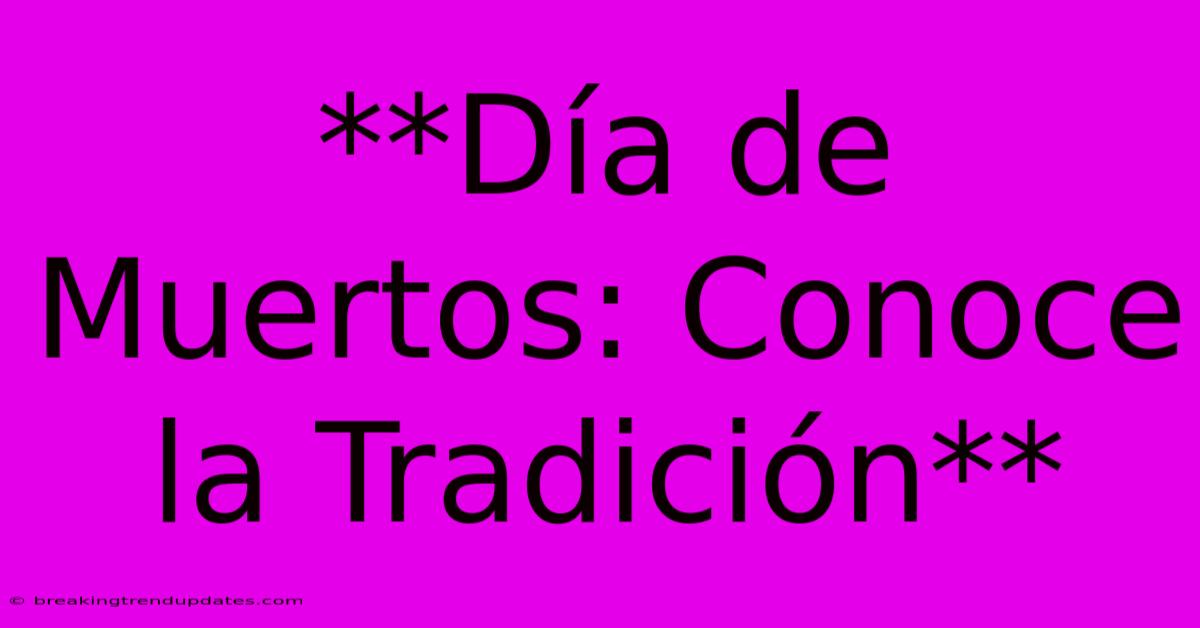**Día De Muertos: Conoce La Tradición**

Discover more detailed and exciting information on our website. Click the link below to start your adventure: Visit Best Website breakingtrendupdates.com. Don't miss out!
Table of Contents
Día de Muertos: Conoce la Tradición
Día de Muertos, or Day of the Dead, is a vibrant and beautiful celebration that honors the lives of those who have passed. It's a time for families and communities to come together, remember loved ones, and share stories and laughter. Celebrated throughout Mexico and parts of the United States, Día de Muertos is a rich tapestry of tradition, culture, and spiritual belief.
The Origins of Día de Muertos
The roots of Día de Muertos can be traced back to the ancient Aztec civilization. The Aztecs believed that the souls of the dead returned to the earthly realm for a brief period each year, and they celebrated this occasion with offerings and festivities. The celebration was originally dedicated to the goddess Mictecacihuatl, the ruler of the underworld, and the festival lasted for a month.
The Celebration of Día de Muertos Today
Today, Día de Muertos is celebrated from October 31st to November 2nd. The first day, October 31st, is known as Día de los Angelitos, or Day of the Little Angels, and is dedicated to remembering deceased children. November 1st, known as Día de los Muertos, is for honoring adults who have passed away. The final day, November 2nd, is a day of remembrance for all deceased loved ones.
Key Elements of Día de Muertos
1. Ofrendas (Altars):
- At the heart of Día de Muertos celebrations are the ofrendas, or altars. These are meticulously crafted displays adorned with photos of the deceased, their favorite foods and drinks, candles, incense, marigolds, and other symbolic items.
- Marigolds (Cempasúchil): These vibrant orange flowers are believed to guide the souls of the deceased back to the earthly realm. Their aroma and color are said to attract the souls, leading them back to their families.
- Pan de Muerto (Bread of the Dead): A special bread made with anise and decorated with bone-shaped dough. It is shared with loved ones and placed on the ofrendas.
- Sugar Skulls (Calaveras de Azúcar): Colorful, decorative sugar skulls, often personalized with names and placed on the ofrendas or given as gifts. They symbolize the sweetness of life and the reminder that death is a natural part of the life cycle.
2. Food and Drink:
- The ofrendas are filled with the deceased's favorite foods and beverages. These offerings are not just symbolic, but also a way for families to connect with their loved ones and share a meal together.
- Mole: A rich and flavorful sauce made with chili peppers, chocolate, and other spices.
- Tamales: Steamed corn dough filled with meat, cheese, or vegetables.
- Atole: A warm, sweet beverage made from corn flour.
- Tequila: A traditional Mexican spirit, often used in cocktails and toasts.
3. Music and Dancing:
- Music and dancing are an important part of Día de Muertos celebrations, bringing joy and life to the festivities.
- Mariachi bands: Traditional Mexican musicians who play festive songs and ballads.
- Folk dances: The vibrant and colorful folk dances of Mexico are a way to honor the ancestors and celebrate life.
4. Visiting Cemeteries:
- Visiting the cemeteries is a common practice on Día de Muertos. Families decorate the graves of their loved ones with flowers, candles, and other offerings. They share stories about the deceased and spend time together, reflecting on their lives.
The Importance of Día de Muertos
Día de Muertos is more than just a celebration of death; it's a celebration of life. It's a reminder that death is a natural part of the cycle, and that we should cherish and remember those who have passed on. This beautiful tradition allows us to reflect on our own mortality and the importance of family, community, and remembrance.
Explore Día de Muertos
If you're interested in learning more about Día de Muertos, there are many resources available online and in libraries. You can also visit museums and cultural centers that host events and exhibitions related to this rich and fascinating tradition.
Whether you are celebrating Día de Muertos with your family and friends or simply learning about this unique cultural event, it is an opportunity to connect with your loved ones and appreciate the beautiful cycle of life and death.

Thank you for visiting our website wich cover about **Día De Muertos: Conoce La Tradición**. We hope the information provided has been useful to you. Feel free to contact us if you have any questions or need further assistance. See you next time and dont miss to bookmark.
Thank you for visiting our website wich cover about **Día De Muertos: Conoce La Tradición**. We hope the information provided has been useful to you. Feel free to contact us if you have any questions or need further assistance. See you next time and dont miss to bookmark.
Featured Posts
-
Widzew Lodz Wygrywa Z Lechia Zielona Gora Po Karnych
Nov 01, 2024
-
Young Thug Pleads Guilty Gang Drug Gun Charges
Nov 01, 2024
-
Southport 18 Jaehriger Wegen Terrorismus Angeklagt
Nov 01, 2024
-
Godoy Cruz Victoria Clave Ante Atletico Tucuman
Nov 01, 2024
-
Panteon San Fernando Festival Cultural Anual
Nov 01, 2024
